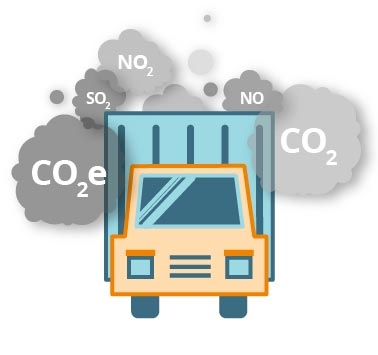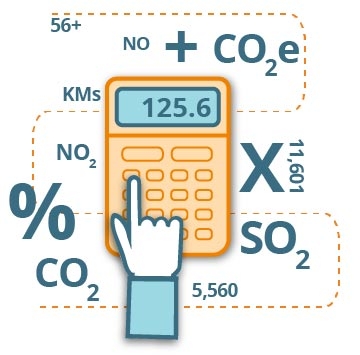CO2 Facts

What is carbon dioxide CO2?
CO2 is the chemical formula for carbon dioxide, a gas emitted when carbon-based fuels like diesel, aviation fuel, or gasoline are burned to generate energy. Most trucks, aircraft, and ships use carbon-based fuels.

What is CO2e?
CO2e or “carbon dioxide equivalent” is a standard unit for measuring carbon footprint. Shipa Freight uses CO2e to measure greenhouse-gas impact (from all types of greenhouse gas) by equating it to the amount of carbon dioxide that would create the same amount of warming. Our CO2e emissions reports express various greenhouse gases as kilograms of an equivalent amount of CO2.
What other gases are included in CO2e estimations?
Aside from carbon dioxide, there is a range of other greenhouse gases, which include sulfur dioxide, nitric oxide, and nitrogen dioxide. Each of these gases can cause warming when emitted into the atmosphere.
CO2 emissions in the transportation sector
The logistics sector plays an important role in the field of greenhouse gas (GHG) emissions. Logistics contributes to about one-fifth of global GHGs, although it only represents 10 percent of the global GDP. It is responsible for up to 30 percent of total transport-related CO2 emissions and around 20–40 percent of total energy use. With higher volumes transported by road rather than rail or water, it is also estimated that approximately 13–15 percent of all road traffic relates to freight transport.
To reduce this impact on climate change, companies are focusing on increasing efficiencies through better transportation management practices among other things. One way to achieve this objective is through improved logistical planning that identifies more sustainable modes when transporting goods. This will have a direct impact on carbon dioxide emissions.
Several companies have already recognized the benefits of reducing CO2 emissions in their supply chains and have implemented innovative strategies to do so.
Why do we need to care about CO2 transportation emissions?
Shipping between continents is by far the most important economic activity. Without it, we could not enjoy a daily supply of goods and services, because no other transport system could serve the vast distances involved.
But there is a dark side: for decades shipping extensively contributed to global greenhouse gas (GHG) emissions and continues to do so today.
The industry's annual CO2 output is estimated at around 1 billion tonnes – about 2% of total GHG emissions– but it has been difficult to pinpoint the exact quantity emitted by ships as they move from country to country along international sea routes.
However, a mandate was passed in 2012 that requires all new ships over 500 gross tonnages (gt) to comply with an energy efficiency design index (EEDI), which means that their fuel consumption is limited to a certain amount per nautical mile.
The industry is developing new types of ships, with novel propulsion systems and the most cutting-edge low carbon technologies, which are designed to keep GHG emissions at acceptable levels in years to come. But this means changing its practices of building and operating vessels.
There has also been progress outside shipping itself: under the Paris Agreement, almost all countries have agreed on legally binding targets for reducing greenhouse gas emissions; they will need technical support in achieving these goals. One of the ways they can do that is by using international shipping mechanisms that provide access to worldwide emission reductions (CERs). These instruments enable countries that need more time than others in the transition towards low carbon policies, to acquire CERs that come from emission reductions achieved by other countries – a system called "international emissions trading" or IET.
The industry will have to work hard if it is going to make its contribution towards reaching the Paris Agreement's goal of limiting global warming below 2°C compared with pre-industrial levels. In 2016, an international group of experts set out a plan pointing out how this could be achieved. It showed that early action on CO2 emissions will help the shipping sector contribute to realizing the overall climate goals and included a list of potential actions for reducing emissions during the next decade.
However, further progress requires supportive policies and economic frameworks that stimulate low carbon technologies at competitive costs as well as harmonized environmental rules.
How does Shipa Freight measure global transport CO2e emissions?
We use the UK Department of Environment, Food and Rural Affairs’ (Defra) methodology, standards and conversion factors to estimate CO2e emissions from customers’ transportation activities. You can learn more about Defra methodology and conversion factors here.

Why do we provide CO2e emissions estimates to our customers?
We provide these estimates to help our customers understand how their operations may affect our climate. This gives them the opportunity to make informed decisions about reducing emissions and so contributing to environmental improvement.
What does "CO2e emissions estimate" mean?
This means that when transporting your shipment with Shipa Freight, the process will create “at least” the amount of CO2e emissions reported by our app. It is likely that the Shipa Freight CO2e emissions estimate for your shipment will be understated, as it does not cover all activities and variables related to the shipment.
For example, our report does not include emissions related to storage or warehouse activities, or the effects of radiative forcing in air transportation. The report is also based on average—as opposed to actual—truck utilization, fuel consumption, and other technical variables that may influence CO2e emissions measurement.
Can I use my CO2e Report for Offsets, or Payment of Carbon Taxes or Fees?
If you are voluntarily offsetting CO2 emissions by planting trees or investing in renewable energies, you can use these reports, provided you indicate that there were likely more CO2 emissions than estimated, and factor our “at least” approach into your voluntary offset strategy.
These reports are not appropriate for carbon taxation, mandatory carbon fees or charges, or involuntary offset programs. To reiterate, we consider our reports to represent an “at least” amount of CO2e emissions. You should always assume that your actual CO2e emissions are higher than the reported estimates.

How can I learn more about Shipa Freight’s sustainable shipping & CO2e emissions reporting?
Would you like further information about our CO2e emissions estimation & reporting program? Perhaps you’re curious about shipping solutions that are less carbon-intensive.
You’ll find plenty of information about these topics on our website, or you are very welcome to reach out to us with your questions.


